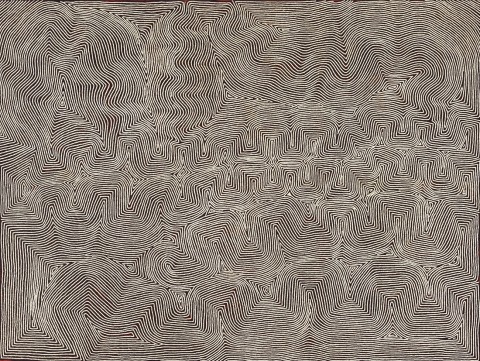MARAWA, 2004
WARLIMPIRRNGA TJAPALTJARRI
synthetic polymer paint on linen
182.0 x 242.0 cm
bears inscription verso: artist's name, size and Papunya Tula Artists cat. WT0410052
Papunya Tula Artists, Alice Springs, Northern Territory
Gallery Gabrielle Pizzi, Melbourne (label attached verso)
Private collection, Sydney, acquired from the above in April 2005
When Warlimpirrnga Tjapaltjarri arrived in the settlement at Kiwirrkura (a remote community near the Pollock Hills in Western Australia) in 1984, having led his small family group out of the desert for the last time, he not only made international headlines as one of “the last uncontacted nomadic tribesmen of the world”, but was subsequently catapulted into a vastly different way of life. His Pintupi relatives had almost all been brought out of the Gibson Desert decades earlier by the infamous ‘Pintubi Patrols’, settling in Ikuntji and Papunya. The extended time Warlimpirrnga spent living a traditional way of life on remote lands west of Lake MacKay and his precocious attainment of the role of maparntjarra (healer) commanded instant respect amongst his relatives in Kiwirrkura and further afield. Notwithstanding these auspicious beginnings, Warlimpirrnga’s experience in joining the community and seeking out art materials to paint his tjukurrpa, were no different to that of his relatives Freddy West Tjakamarra or Yanyatjarri Tjakamarra, who some decades earlier had introduced the men’s stories of the Tingari to Western art audiences.1
Marawa, 2004, is a distinctive dichromatic painting of interlocking Tingari designs carefully mapped out in Warlimpirrnga’s subtly individual fine, shimmering meandering lines and stippled dots on an ochre and black ground. Pintupi men had a profound influence on the emergence of Western Desert art in Papunya from the early 1970s, with artists such as Ronnie Tjampitjinpa, Uta Uta Tjangala and Antatjari Tjakamarra presenting their sacred stories of Tingari creation of the natural landscape and advocating for their people’s return to country (leading to the establishment of Kintore and Kiwirrkura). These songlines were gradually adapted from and reflected the potency of ritual sand drawings and incised objects. On the most literal level of interpretation, Marawa, like many other Western Desert paintings, is a “map”, a topographical aerial view of ancestral lands combined with a codified mnemonic system of symbols conveying the tjukurrpa and ceremonies associated with this site west of Wilkinkarra (Lake Mackay).
This tight and well-resolved composition is a painting referring this site of rockhole and soakage water from which Warlimpirrnga came, a vast land that he continues to roam to this day. Oral histories speak of the Tingari beings arriving at this site from the west, travelling beneath the earth’s surface to create the ridges and windswept sandhills that unfold across the canvas, pulsating and radiating beyond the physical limits of the rectilinear canvas. While Warlimpirrnga’s abstraction, similar to that of George Tjungurrayi, undoubtedly creates a range of rich optical effects, reminiscent of Western Modernist artworks, the cosmological power of his artworks surpasses their aesthetic and formal qualities. The partial revelation of certain elements of the artist’s tjukurrpa, keeping most hidden from the uninitiated, quietly commands recognition and respect of the persistence and beauty of aboriginal culture, the world’s oldest continual line, and the law that underpins it. Warlimpirrnga’s skill and confidence as a painter has led to global recognition of his work and its stories, with his paintings held in prestigious public collections and exhibited internationally alongside the best examples of contemporary art.
1. a Tjukurrpa, regionally specific to the Western Desert, referring to travelling ancestral beings responsible for the creation of the landscape and generally depicted as interconnected concentric circles
LUCIE REEVES-SMITH
